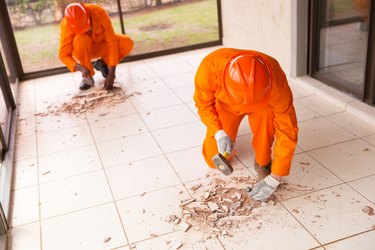In This Article
Tiles are an attractive and durable method of covering your floor. They're particularly good for rooms with a lot of foot traffic and the potential for water damage, such as kitchens and bathrooms.

However, over time, floor tiles cracking and lifting can be a huge problem. Not only can this look unsightly, but it can pose a safety hazard in terms of tripping over. Repairing lifting tile flooring as quickly as possible can help prevent these issues becoming worse or causing more lifting and cracking.
Video of the Day
Video of the Day
Why Would Floor Tiles Lift Over Time?
If tiles have been improperly installed or installed a very long time ago, they can start to dislodge and lift up. If the wrong type of tile adhesive was used originally, this can mean they are more prone to becoming dislodged. Even the correct type of adhesive can become worn over time and lead to tiles lifting.
Floor tiles can also lift as a result of excess moisture, typically coming from below. Moisture can also effect tiles that have not been adequately sealed. Substrate movement can also have an adverse effect on floor tiles, particularly a house "settling."
Luckily, repairing tile flooring that is lifting can be achieved by you, at home. Knowing whether you're using tile adhesive or mortar is key to getting the repair job right. The processes can also be used when fixing wall tiles.
How To Repair Loose Floor Tile With Glue
When you repair loose floor tile, first check over the tiles in question to determine which have lifted or become loose. Mark these out with chalk or another easy-to-remove substance. Then, using a tea towel and an iron, press over the tiles that you've marked out as loose. This will help loosen the glue holding the non-lifting parts of the tile in place.
Use a putty knife to gently lift the entire loose tile from the floor. If its not coming up easily, go over again with the tea towel and iron. Repeat this process until all of the lifting tiles have been fully removed.
Set aside these free tiles and inspect them for damage. Tiles that are cracked or otherwise misshapen should be discarded and replaced.
Using white spirit and a rag, remove the leftover glue both from the tiles you're reusing and the floor. You can scrape away any large sections of glue or sand down any extra stubborn areas – just make sure you're left with two smooth surfaces.
You can now reglue your tiles. Start with a thinner layer of adhesive, using more if you need the tile to be slightly elevated. Press each tile from its middle to each of its corners to remove any potentially trapped air.
Tile Repair With Mortar
When it comes to tile repair with mortar, rather than heating up and softening as with glue, you'll need to crack the mortar. Use a putty knife and a hammer, and once the tile is loose, you can gently pull it up. Scrape away any leftover mortar, both on the floor and on the tile, using the same putty knife.
Again, check the removed tiles for any damage. If they are uneven or cracked, they'll need to be fully replaced.
Mix your new mortar and apply in the areas needed using a notched trowel. Place your tile in the gap and check that it's level with the rest of the floor. If not, add or remove mortar underneath as needed. Allow at least a day for the mortar to dry.
You can then grout the gaps between the tiles. Don't worry about excess grout, as it can be removed with a damp cloth before it sets.